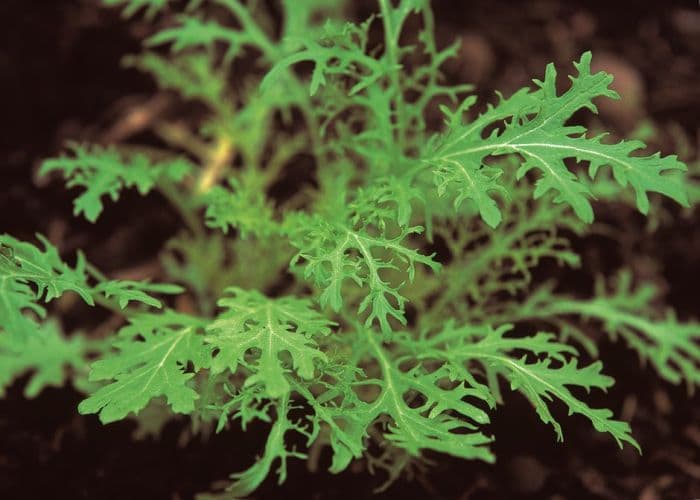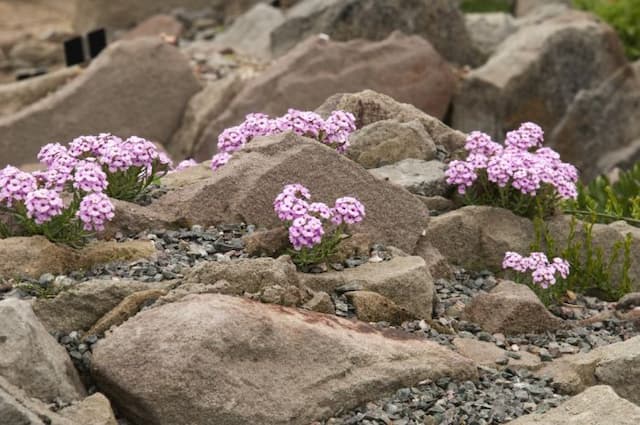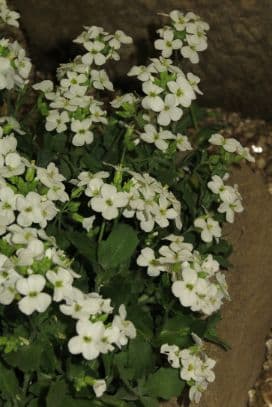Mustard Greens Brassica juncea 'Golden Streaks' (PBR)

ABOUT
The 'Golden Streaks' is a visually striking variant of the mustard greens family, characterized by its vibrant golden-yellow leaves. These leaves are delicately serrated and have a feathery texture, creating an ornamental appeal in addition to their culinary uses. The foliage is richly pigmented with lively hues ranging from bright chartreuse to deep golden tones that can add a splash of color to any garden setting. The plant itself grows in a luscious clump, where the leaves splay out from the central stem, creating a rosette-like effect that is aesthetically pleasing to the eye.
About this plant
 Names
NamesSynonyms
Mustard Greens, Indian Mustard, Leaf Mustard, Oriental Mustard, Brown Mustard, Chinese Mustard.
Common names
Brassica juncea 'Golden Streaks' (PBR)
 Toxicity
ToxicityTo humans
Mustard 'Golden Streaks' is not considered toxic to humans. It is a variety of mustard greens, which are commonly consumed in various cuisines around the world. However, consuming large amounts of mustard greens, like any food, might lead to digestive discomfort for some individuals, but this does not indicate toxicity.
To pets
Mustard 'Golden Streaks' is also not specifically known to be toxic to pets. However, pets may have different reactions to foods that are typically safe for human consumption. In general, feeding pets moderate amounts of mustard greens is not expected to be harmful, but it's always best to consult with a veterinarian if unsure about the safety of feeding certain plants or foods to your pets. Excessive consumption of mustard greens by pets could potentially lead to gastrointestinal upset due to the plant's fiber content and natural compounds. Nonetheless, toxicity is not a common concern with this plant.
 Characteristics
CharacteristicsLife cycle
Annuals
Foliage type
Deciduous
Color of leaves
Green
Flower color
Yellow
Height
1-3 feet (0.3-0.9 meters)
Spread
0.5-2 feet (0.15-0.6 meters)
Plant type
Herb
Hardiness zones
Varies
Native area
Asia
Benefits
 General Benefits
General Benefits- Economical: The plant is relatively inexpensive to cultivate and maintain, providing an affordable option for gardeners and farmers.
- Culinary versatility: Leaves of this plant can be used in a variety of dishes, adding a peppery flavor similar to that of mustard greens or arugula.
- Aesthetic appeal: With its vibrant golden-yellow streaks, the plant adds colorful interest to gardens and landscapes.
- Easy to grow: It is a hardy plant that can be grown in a range of environments, requiring minimal care once established.
- Fast growth: The plant matures quickly, allowing for rapid cultivation and harvest cycles.
- Edible flowers: In addition to the leaves, the flowers are also edible, offering a decorative and tasty element to salads and garnishes.
- Attracts beneficial insects: The blossoms can attract pollinators such as bees and butterflies, enhancing biodiversity in the garden.
- Soil improvement: As a member of the Brassicaceae family, it can be used in crop rotation to improve soil health and reduce pest issues.
- Tolerance to pests: The plant has natural resistance to many common pests, reducing the need for pesticides.
- Cold-resistant: It can withstand cooler temperatures, making it suitable for early spring and late fall planting in temperate zones.
- Companion planting: It can be grown alongside other crops to deter pests and maximize space in the garden.
- Drought tolerance: Once established, it has a level of drought tolerance, making it suitable for regions with occasional water scarcity.
 Medical Properties
Medical Properties- Antioxidant properties – Brassica juncea, commonly known as mustard greens, contains high levels of antioxidants which may help protect cells from damage caused by free radicals.
- Anti-inflammatory effects – The plant has been noted for its potential anti-inflammatory effects which might be beneficial in reducing inflammation in certain conditions.
- Cancer prevention – Some studies suggest that the phytonutrients present in mustard greens may contribute to the prevention of certain types of cancer, although more research is needed to confirm these benefits.
- Cardiovascular health – The high presence of antioxidants, fiber, and other nutrients in mustard greens may have a positive effect on cardiovascular health by reducing cholesterol levels and supporting heart function.
- Diabetes management – Mustard greens may help regulate blood sugar levels, which could be beneficial for individuals managing diabetes due to their high fiber content and potential to improve insulin sensitivity.
- Detoxification – The plant may aid in detoxification of the liver and blood due to certain compounds it possesses such as glucosinolates.
- Digestive health – Because of its fiber content, mustard greens can promote healthy digestion and prevent constipation.
- Respiratory health – Consuming mustard greens has been associated with relief from symptoms of respiratory conditions due to their anti-inflammatory properties.
 Air-purifying Qualities
Air-purifying QualitiesThis plant is not specifically known for air purifying qualities.
 Other Uses
Other Uses- As a natural dye: The leaves of mustard greens can be used to create a greenish-yellow dye for fabrics or crafts.
- Ink production: Juice extracted from mustard greens can be used as a base for natural inks utilized in artistic works.
- Bioplastic ingredient: Mustard greens may be used in the production of biodegradable plastics due to their organic compounds.
- Cosmetic colorants: Powdered mustard greens could be incorporated into natural cosmetic products as a pigment.
- Garden pest deterrent: Mustard greens can be planted as a companion plant to deter certain pests from more sensitive crops.
- Soil improvement: The cultivation of mustard greens can help in the breakup of heavy soils, thereby improving soil aeration and texture.
- Educational tool: Mustard greens can be used in schools for experiments that teach photosynthesis and plant biology.
- Art supplies: Crushed or pressed leaves can be utilized in creating eco-friendly art materials like papers and canvases.
- Plant-based packaging: Fibrous material from mustard greens can be researched and developed into sustainable packaging solutions.
- Photography: Mustard greens can provide a natural contrasting background for photographers specializing in food or botanic imagery.
Interesting Facts
 Feng Shui
Feng ShuiThe Mustard Green is not used in Feng Shui practice.
 Zodiac Sign Compitability
Zodiac Sign CompitabilityThe Mustard Green is not used in astrology practice.
 Plant Symbolism
Plant Symbolism- Resilience: Often used in mustard greens, Brassica juncea varieties, including 'Golden Streaks', represent resilience as they can thrive in a variety of soils and conditions.
- Prosperity: In some cultures, the green leaves of mustard plants symbolize wealth and prosperity due to their vibrant color and fast growth.
- Fertility: The fast-growing nature of the plant suggests fertility and abundance, similar to the verdant growth seen in spring which symbolizes new life and new beginnings.
- Protection: Historically, mustard has been thought to have protective properties, with mustard seeds used in some rituals and talismans to ward off evil.
- Stamina: The hardy nature of the plant, able to grow in harsh conditions, may be seen to represent the stamina and strength to persevere.
 Water
WaterMustard 'Golden Streaks' prefers consistent moisture, so water the plant when the top inch of soil feels dry to the touch. Water once or twice a week, depending on weather conditions, making sure to soak the soil thoroughly each time. Over a week, a mustard plant typically requires about 1 inch of water whether from rainfall or manual watering. During hot, dry periods, you may need to increase watering frequency. Ensure the plant is not sitting in waterlogged soil as this can lead to root rot.
 Light
LightMustard 'Golden Streaks' thrives best in full sunlight to partial shade. The ideal location is a spot that receives at least 4 to 6 hours of direct sunlight daily. However, it can tolerate some shade, especially in hotter climates where afternoon shade can help protect the plant from excessive heat.
 Temperature
TemperatureMustard 'Golden Streaks' can survive in temperatures as low as 20 degrees Fahrenheit and as high as 80 degrees Fahrenheit. However, the ideal temperature range for optimal growth is between 45 and 75 degrees Fahrenheit. Sudden cold snaps below 20 degrees Fahrenheit can damage or kill the plant, while temperatures above 80 degrees Fahrenheit can cause bolting.
 Pruning
PruningMustard 'Golden Streaks' requires minimal pruning mainly to remove older outer leaves to promote growth or if they're damaged or diseased. This can be done every few weeks or as needed throughout the growing season. Pruning in the early morning when the plant is dry is often recommended to reduce the risk of spreading diseases.
 Cleaning
CleaningAs needed
 Soil
SoilMustard greens like well-draining soil rich in organic matter with a pH between 6.0 and 7.5. A mix of garden soil, compost, and perlite in equal parts works well.
 Repotting
RepottingMustard greens do not typically require repotting as they are fast-growing leafy vegetables usually harvested before needing transplant.
 Humidity & Misting
Humidity & MistingMustard greens prefer moderate humidity levels but are adaptable to various conditions outdoor.
 Suitable locations
Suitable locationsIndoor
Place in well-lit area, keep soil moist, use rich soil mix.
Outdoor
Full sun to partial shade, fertile soil, moderate water.
Hardiness zone
2-11 USDA.
 Life cycle
Life cycleBrassica juncea 'Golden Streaks', commonly known as mustard greens, begins its life as a seed which germinates in warm, moist soil, usually in spring or fall, as the plant is cool-weather tolerant. The seedling develops its first true leaves after the initial cotyledons, and quickly grows into a rosette of heavily fringed, yellow-green leaves. As the plant matures, it enters the vegetative stage, during which it focuses on leaf growth and becomes ready for harvesting of the edible leaves. If allowed to grow further, it will eventually bolt, sending up stalks that will flower and produce small, yellow flowers. After pollination, these flowers develop into seed pods, and once the seeds mature, the plant completes its life cycle. The seeds are then dispersed, either by human intervention or naturally, leading to the next generation of mustard greens.
 Propogation
PropogationPropogation time
Spring to summer
Propogation: The most popular method of propagating Brassica juncea 'Golden Streaks', also known as mustard greens, is through seed sowing. Traditionally, mustard greens are sown directly into well-prepared soil in early spring or late summer, as they are cool-season crops that can tolerate frost. The seeds should be sown about 1/4 to 1/2 inch deep (roughly 0.6 to 1.3 centimeters) and spaced approximately 3 inches (approximately 7.6 centimeters) apart within rows that are 12 to 18 inches (about 30.5 to 45.7 centimeters) apart. Germination typically occurs within 5 to 10 days under optimal conditions, which include consistent moisture and soil temperatures between 45 and 85 degrees Fahrenheit (7 and 29 degrees Celsius). Thinning the seedlings to 6 inches (approximately 15.2 centimeters) apart once they reach a few inches in height will ensure they have enough space to develop fully.



![Aubrieta [Axcent Light Blue]](/_next/image?url=https%3A%2F%2Fplants-admin.emdemapps.com%2Fimages%2Fplants%2F%2Fimages%2F604b5e7128866.png&w=640&q=75)





